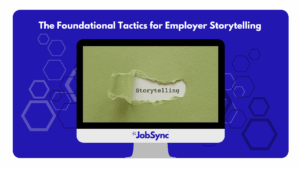In today’s hyper-competitive job market, job descriptions and bullet-pointed lists of benefits just don’t cut it anymore. Top talent isn’t just looking for a job; they’re looking for a purpose, a community, and an environment where they can thrive.
 To attract and retain these individuals, employers must stop simply advertising open positions and start becoming compelling storytellers.
To attract and retain these individuals, employers must stop simply advertising open positions and start becoming compelling storytellers.
Your company’s career site and social media channels are your stage. This is where you have the opportunity to paint a vivid, authentic picture of what it’s truly like to work for you. It’s about shifting the focus from what you want from a candidate to what you have to offer them, and doing so in a way that resonates on a human level. A well-executed content strategy can transform your career site from a static list of openings into a dynamic hub of your company’s culture, values, and vision.
Why Storytelling is Your Most Powerful Recruitment Tool
Stories are 22 times more memorable than facts alone. A compelling narrative creates an emotional connection, making your company more relatable and real. It’s how you move a candidate from passive observer to engaged applicant. The goal is to build a brand identity that not only attracts talent but also acts as a filter, drawing in people who share your values and will be a great cultural fit. This authenticity is key—candidates today can see right through overly polished, inauthentic messaging.
To understand how this content strategy works in practice, look at companies that have mastered the art of employer storytelling. Salesforce, for instance, has built its entire employer brand around the concept of “Ohana,” the Hawaiian word for family. Their career site and social media channels are filled with vibrant stories of employees who feel a deep sense of belonging, purpose, and community. They showcase volunteer events, mentorship programs, and personal growth stories that demonstrate how this “Ohana” philosophy is not just a buzzword, but a lived reality.
Another great example is Netflix. Known for its radical transparency, Netflix’s “Culture Memo” is a public document that openly outlines its values and expectations. Their “We Are Netflix” YouTube channel and social media campaigns feature unscripted, behind-the-scenes content that gives a genuine look into the roles of their creative and technical professionals. These companies succeed because they don’t just sell a job; they sell a culture, a mission, and a promise of an impactful career journey.
So, how do you become a master storyteller? It’s about creating a consistent, engaging content calendar that brings your company to life. Here are the specific types of weekly and monthly content you should be creating and publishing to your career site.
Weekly Content: A Glimpse into the Day-to-Day
Weekly content keeps your audience engaged and provides a consistent flow of fresh, authentic insights. This is your chance to show, not just tell, what makes your workplace unique.
1. Employee Spotlight Blog Posts
This is the cornerstone of your storytelling strategy. Every week, feature a different employee. Go beyond their job title and responsibilities. Focus on their journey—how they joined the company, a project they’re proud of, a challenge they’ve overcome, and what they love most about working there.
- Example: A blog post titled, “From Intern to Team Lead: Sarah’s Journey in Product Development.”
- What it does: It humanizes your company, showcases career growth opportunities, and provides a relatable face for a potential candidate. It also gives your current employees a moment to shine, boosting morale and making them feel valued.
2. “Day in the Life” Videos or Photo Series
Nothing is more powerful than a visual journey. A short, unscripted video or a series of photos can give candidates a real-time feel for the work environment.
- Example: A 60-second video following an engineer on a typical day, showing them in a team meeting, grabbing coffee, and collaborating with a colleague. Or a photo series of a marketing team’s brainstorm session.
- What it does: It provides transparency and demystifies a role. Candidates get a tangible sense of the work-life rhythm, the office environment, and the team dynamics.
3. “Ask Me Anything” (AMA) Sessions
Host a live Q&A session with a team member on your blog or a social media channel. This can be a text-based Q&A or a short video.
- Example: “Ask a Senior Data Scientist Anything: Live Q&A with Mark.”
- What it does: It builds a direct connection with potential candidates and allows them to get their specific questions answered in real-time. It shows your company is open, transparent, and values engagement.
Monthly Content: Deeper Dives and Big-Picture Narratives
Monthly content allows you to tackle more in-depth topics and showcase the bigger picture of your company’s mission and impact.
1. Project Showcase or Case Study
Dedicate a blog post or a longer-form video to a specific project your team recently completed. This should be a collaborative piece, featuring quotes from different team members who worked on it.
- Example: “The Making of ‘Project Genesis’: How Our Engineering and Design Teams Built Our New Product.”
- What it does: It highlights the meaningful work your employees are doing and gives candidates a sense of the challenges they would be solving and the impact they could have. It also showcases cross-functional collaboration and teamwork.
2. Leadership and Culture Insights
Feature a post from a member of your leadership team. This content should be less about corporate jargon and more about the leader’s personal philosophy on management, their vision for the company, and the values that drive them.
- Example: A blog post from the CEO titled, “Why We Believe in [Your Company Value] and How We Live It.”
- What it does: This type of content establishes trust and shows that your company’s values are not just words on a wall but are actively championed from the top down. It helps candidates understand the leadership style and the direction of the company.
3. Community and Social Impact Stories
Modern job seekers are often looking for companies that align with their personal values and make a positive impact on the world. Showcase your company’s social responsibility efforts.
- Example: A blog post or video highlighting a volunteer day, a partnership with a local charity, or a diversity and inclusion initiative.
- What it does: This demonstrates that your company is a responsible corporate citizen and cares about more than just the bottom line. It attracts purpose-driven candidates who want to be part of something bigger.
4. “Behind the Benefits” Series
Go beyond simply listing your benefits. Create content that explains the “why” and “how” behind them, featuring stories from employees who have utilized them.
- Example: “Work-Life Balance Isn’t a Myth: How Our Flexible Schedule Helps Me as a Working Parent.”
- What it does: It brings your benefits to life and shows how they translate into a better quality of life for your employees. This is far more impactful than a bulleted list on a static page.
The Foundation of Your Storytelling
For all of this content, remember these key principles:
- Authenticity is Non-Negotiable: Don’t script your employees. Let them tell their stories in their own words. Unpolished, genuine content is far more effective than a slick, corporate video that feels disingenuous.
- Use Visuals: Every piece of content should be accompanied by high-quality, authentic photos or videos. A picture of an employee smiling at their desk is more compelling than stock photography.
- Cross-Promote Everything: Don’t let your content live in a silo. Share your blog posts on your company’s social media channels (LinkedIn, Instagram, Twitter), and link to relevant job openings at the end of each post.
- Make it Accessible: Ensure your content is easy to find on your career site. Create a dedicated blog or “Life at [Company Name]” section.
By embracing this content strategy, you’re not just filling open roles—you’re building a community around your EVP. You’re inviting candidates to imagine their own story unfolding within your company. You’re showing them that your workplace is a place of growth, purpose, and genuine human connection. This is the new way to attract talent, and it’s a story worth telling.


